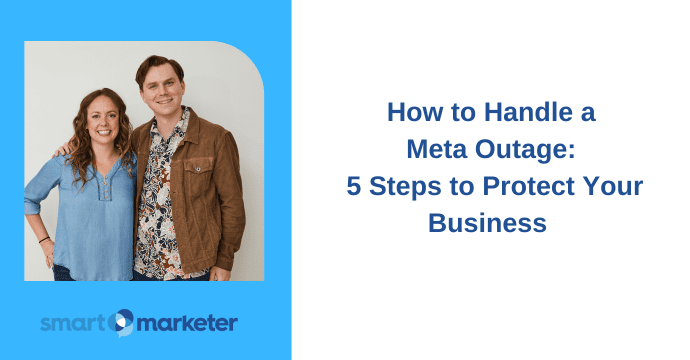
On December 11, 2024, Meta experienced an outage across all its major properties — including Facebook, Instagram, WhatsApp, Threads, and Messenger — due to technical issues. Millions of users and businesses around the world were affected, including us here at Smart Marketer.
The good news is that these outages are rare. But that’s a small consolation to marketers and business owners who rely on Meta ads for growth.
Obviously, you can’t prevent the next Meta outage. But by taking action quickly you CAN minimize damages, get your ads up and running, and restore your campaign performance as quickly as possible.
So how do you do all that? Here are the 5 steps we recommend:
Step 1: Make sure it really is an outage.
This might sound simple, but if you find yourself unable to open the Facebook Ads Manager, for instance, first make sure that the problem isn’t on your end.
Check that your internet’s working and that you don’t have any firewall issues or anything like that. You can also check https://metastatus.com/ to see if Meta has had any issues reported lately.
If the problem seems to be on your end, try clearing your cache or using a different browser. If the problem really is a Meta outage, move on to step 2.
Step 2: Document problems, if you can.
During a Meta outage, it helps to document the problems you’re experiencing. For instance, if you can’t pause your campaigns, take a screenshot or a screen recording to demonstrate that.
This proof might help your case when you request compensation later on.
Step 3: Keep an eye on performance.
When services are resorted and your ads start running again, DON’T just assume that everything will be fine! You should monitor performance for 12–24 hours.
Sometimes after an outage, you may find that your campaign performance has taken a nose-dive. If that happens, your ads may benefit from a reset. In this case, you should:
- Turn off all the campaigns or ad sets that are performing badly
- Then duplicate them and start running the new campaigns
This isn’t guaranteed to fix things, but it’s definitely worth a shot. I’ve seen it work more than once.
Oh, and if you had plans to launch a new campaign at this time, you might want to postpone that until you’re confident everything is running smoothly again.
Step 4: Request compensation.
Next, message Meta support (or your account manager, if you have one) with a request to be compensated for the outage.
They will usually want a reason for this, so be prepared to give them something specific, like:
- IDs of campaigns that had poor deliverability and results
- Screenshots of being unable to pause campaigns, etc.
It can be hard to get compensated during these outages, but sometimes it works, so it’s worth asking.
Step 5: Diversify your traffic sources.
Obviously, this is a big step — but it’s well worth the effort, especially if you’re so reliant on Meta ads that an outage brings your new customer acquisition to a screeching halt.
In that case, consider getting started with another ads platform using one of our Smart Marketer courses such as Smart Google Ads or Smart Amazon Ecommerce.
In addition, the email marketing system you’ll learn in Smart Email Marketing can also be an effective way to maintain control over your ability to contact your own prospects.
This is the most time-consuming step I’m recommending in this post, but it might also be the most important one. By diversifying your traffic streams, you’ll be building a more resilient business that’s better able to weather the inevitable ups and down that occur on any individual platform.
* * * * *
That’s it. Follow these 5 steps to minimize the negative impact from a Meta outage.
Thanks for reading!



